 Employee Experience Best Practices
Employee Experience Best Practices
An employee experience strategy enables organizations to increase engagement and build a productive, satisfied workforce. Our free, easy tips show you how.

.png)
Strategy is an important component of internal communications. Ensure you’re communicating through the right channels at the right frequency with our Internal Communications Channel Audit worksheet.
Access NowThere’s nothing new about the employee experience concept. But an increasing number of organizations are prioritizing its importance - at least in part.
allagher’s State of the Sector 2022/2023 report states that 72% of the respondents in their most recent Internal Communication and Employee Experience survey believe employee experience is “on their leadership’s radar.” About one-third of these people say their organizations have a clear mandate to improve it. However, the report highlights the fact that organizations only prioritize some components of the employee experience and neglect others.
It’s complicated, but we need to consider how businesses can create better, more memorable, and engaging experiences for their employees. It’s also important to understand why an effective employee experience strategy is essential.
In this article, we’re going to delve into the significance of employee experience and the strategic measures necessary to enhance it. We will also explore a practical 10-step approach toward building an efficient employee experience strategy and touch on some of the potential hurdles businesses face during its implementation. Our guide provides invaluable insights on transforming the workplace into a fulfilling, collaborative, and employee-centric environment.
The employee experience, often referred to as EX, encompasses interactions and perceptions your workforce has about their employment at your organization. It covers every touchpoint in the employee lifecycle, from an employee’s job application and onboarding process to career development, performance reviews, and their eventual exit from the company. A positive employee experience reaps an array of benefits, like higher performance scores, improved employee retention, and a stronger bottom line for the company.
Research by Salesforce shows that investing in employee experience can result in revenue and profits increase, as well as ROI. Customer-facing companies experienced more than 50% increase in revenue, as well as a 10-year ROI in excess of 80%.
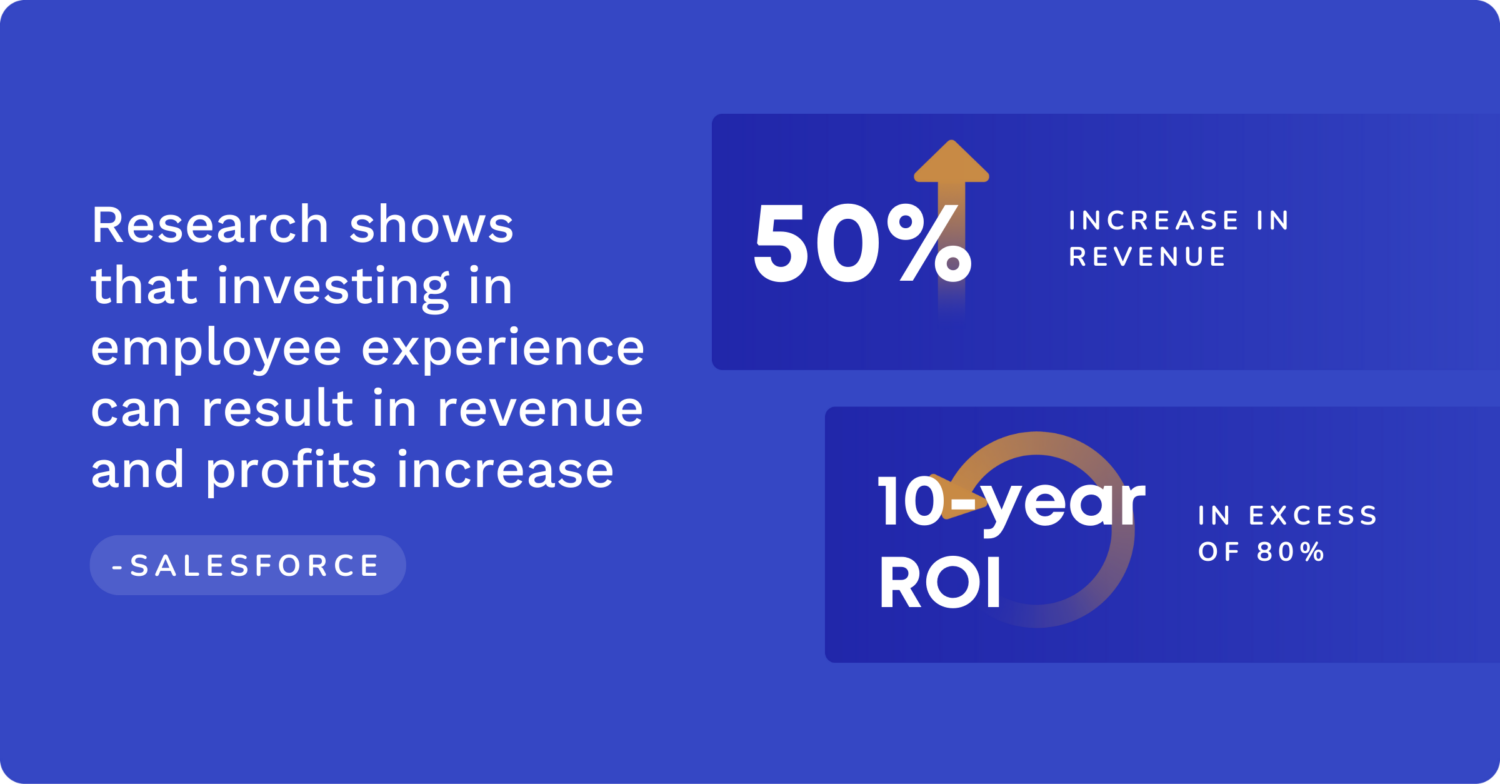
“Our results provide powerful evidence that employees drive customer experience and top-line business growth and represent a key proof point for HR leaders seeking employee investments. Our analysis illustrates the value of connecting people data with financial data. By breaking down these data silos, executives can begin to see the powerful link between employees, customers, and revenue.” Salesforce research paper
EX isn’t merely a single event. Rather, it encompasses every aspect of an employee's working experience. It begins at the first point of contact as potential team members start to form an impression of your organization and continue throughout their tenure, painting a total experience that captures every facet of their employment journey. More than just employee engagement or satisfaction, EX aims to promote an environment where employees feel genuinely valued, satisfied, and inspired to deliver their best.
A well-crafted employee experience strategy is vital to an organization’s success and its reputation among job seekers. It focuses on providing an employee experience that will increase engagement and help to build a company culture that values and respects its team members. Several aspects demonstrate why EX is so crucial:
Companies that prioritize employee experience often find they’re not just a business with workers, but a unified team moving towards a shared vision. An effective employee experience strategy can impact every facet of your organization's performance from customer experience to the company's bottom line. And it’s all driven by the all-important employee experience.
Upgrade your company’s internal comms to enhance employee communication
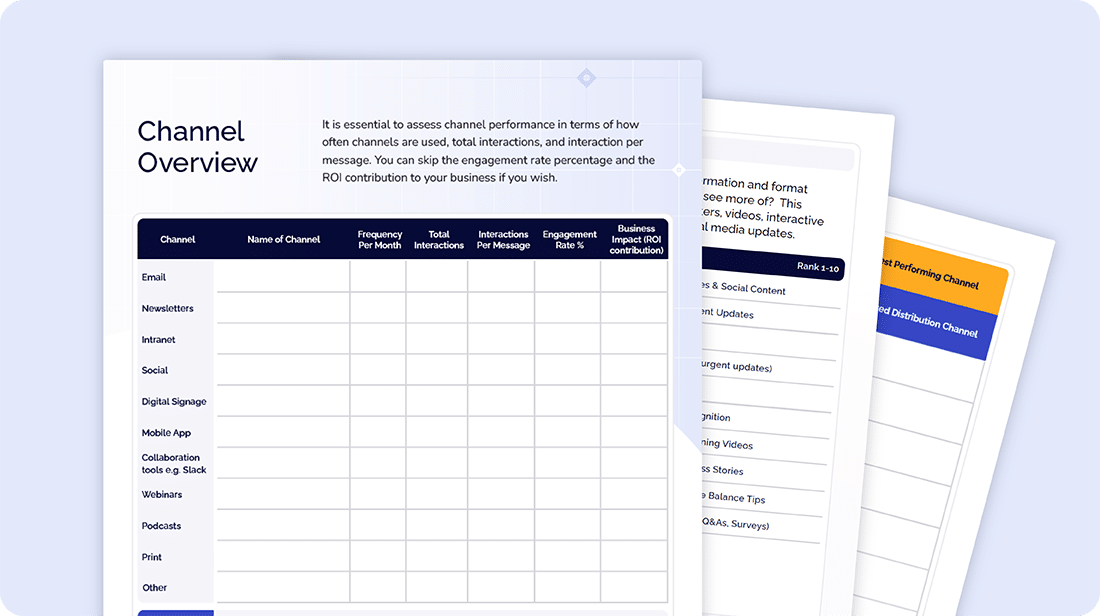
Gallagher identifies the components that various organizations do and doesn’t prioritize. Their survey asked respondents to specify which of these six options their organizations have a clear strategy for. Each of them is an important element that plays a pivotal role in the employee experience. You will see that purpose and strategy are identified as being leveraged the best.
Respondents were asked, Does your organization have a clear strategy for each of the following components of the employee experience? The percentages shown in brackets are for those organizations that aren’t doing anything to prioritize that particular employee experience. The balance indicated that they either had a well-defined concept or an employee experience strategy that was “in development.”
Interestingly, the survey indicates that organizations really do value employee feedback (84%), and a lot more than half (65%) say they learn from and act on this feedback. A bit less than half (47%) say their organizations have “a robust process” that is used to capture employee feedback and insight.
The survey also collected data on the listening channels that respondents from various organizations use to collect employee feedback and views. The top three listed are engagement surveys (69%), email (55%), and feedback from people managers (51%).
They found that only 8% have bothered to use communication audits that are conducted by an external organization - a tool that we at Cerkl find incredibly effective.
If employee experience isn't currently a strategic priority in your organization, it’s time for a shift. Making EX a priority involves carving out a dedicated approach toward designing and improving the employee journey, fostering engagement, and creating a culture of recognition and growth.
Remember, employee experience isn’t a one-time project, but a continuous journey of refinement, assessment, and enhancement. It means continually tuning in to the needs of your employees, ensuring their voice is heard and valued, and maintaining a strategic focus on their experience.
An employee experience strategy is a holistic, data-driven approach to creating an environment where employees feel valued, connected, and motivated to perform at their best. It encompasses every touchpoint in the employee lifecycle, from the moment an individual submits a job application, through onboarding experience, performance reviews, and career development, to the day they leave the company. This strategy's primary aim is to design an effective working experience that drives employee engagement and ultimately improves bottom-line business results.

It is often said that happy employees make for happier customers. However, providing a positive employee experience is not just about making employees happy. It is about designing a work environment and processes that allow employees to flourish professionally while ensuring they feel their contributions are valued.
HqO presents useful strategies to improve employee engagement in its 2023 edition of The State of Workplace Experience. In its predictions for the coming years, their report states that by 2024: “Organizations with a persistent cross-functional team tasked with workplace experience strategy will be 80% more likely to have high employee satisfaction with the workplace.”
An effective employee experience strategy typically includes but is not limited to:
It's a unique fusion of HR practices, technology, and effective management that puts the people in your organization who matter at the center of all decisions.
Upgrade your company’s internal comms to enhance employee communication

In its 2023 Employee Experience Trends, Qualtrics states that current 2023 innovations and transformations in employee experience focus on a desire “to make business more human — and to establish deeper, more meaningful connections through the work we do.”
Their survey found that a belief in organizational values is a top driver for employee experience that leads to inclusion and an “intent to stay” on the job. As many other research studies have found, Qualtrics states that “being employed isn’t just about having an occupation and earning a competitive salary – it’s also a core part of a person’s value system.” At the same time, pay and benefits are rarely a driver of employee experience.
Here we outline 10 steps you can use to build your perfect employee experience strategy:
Creating a positive employee experience begins with understanding the needs and wants of your team members. This can be achieved by regularly conducting engagement surveys and providing employees with opportunities to share their experiences and suggestions.
Performance scores and feedback from these surveys will provide valuable insights into what is working well and what areas need improvement. Review these reports to identify trends or patterns and note areas that consistently score low.
An organization's culture plays a significant role in an employee's experience. Conduct a cultural assessment to understand your organization's unwritten rules and behaviors. Surveys, focus groups, and one-on-one interviews are practical methods to gather this data. The goal is to determine if your culture supports or hinders a positive employee experience.
Once you've gathered feedback and assessed your company culture, it's time to define your EX objectives. What do you want to achieve with your employee experience strategy? You could aim to improve engagement scores, boost retention rates, or create a more positive atmosphere, for instance. Set clear, measurable goals to monitor progress and determine the strategy’s effectiveness.
Employee personas are fictional representations of the different types of employees in your organization. Creating these personas can help you understand the diverse needs, motivations, and challenges your employees face. Design your strategies to address these unique needs to provide a more personalized and positive employee experience.
Journey mapping is a design thinking tool used to visually depict employees' experiences throughout their lifecycle in your company. It helps identify pain points and moments that matter most to your employees, allowing you to prioritize and design interventions that enhance their overall experience.
Microsoft’s recent survey found that employees are looking for tools that enable collaboration seamlessly, automate repetitive work, and guide with insights, that can be customized for specific business challenges.
Technology is crucial in delivering a seamless employee experience. From simplifying the job application process to the onboarding process and continuous learning opportunities, the right technology can greatly enhance the employee experience. Consider tools that enable online collaboration, streamline HR processes, and offer well-planned virtual training programs.
This topic is discussed in The Tech-Enabled Employee Experience, the 2022 Culture Report from Achievers Workforce Institute. It states that business leaders are “wary of evolving to the new way of working, with 56% of HR leaders saying the C-suite doesn’t recognize that attraction and retention has changed.” Additionally, 45% of HR leaders maintain that they don’t have the C-suite leadership support they need to implement the initiatives necessary to attract and retain employees.
An effective EX strategy requires the buy-in and support of senior leadership. Ensure the objectives of your strategy align with the overall business goals and that your senior leaders are champions for improved employee experience. A top-down approach will increase acceptance and participation in the strategy across all levels.
While commitment from the top is essential, managers and team leaders play a critical role in the daily experiences of your employees. Training programs need to be designed to help team leaders understand the importance of EX and provide them with the skills to foster a positive work environment.
Integrating your EX framework into daily operations will ensure that it is not just a one-time project but a part of your company's DNA. The HR teams should work closely with managers to embed EX best practices into day-to-day activities.
Your employee experience strategy should be flexible, as needs and conditions can change over time. Continuously monitor and adjust your strategy based on feedback, performance scores, and evolving business priorities. Use the feedback from engagement surveys to refine and enhance your EX initiatives.
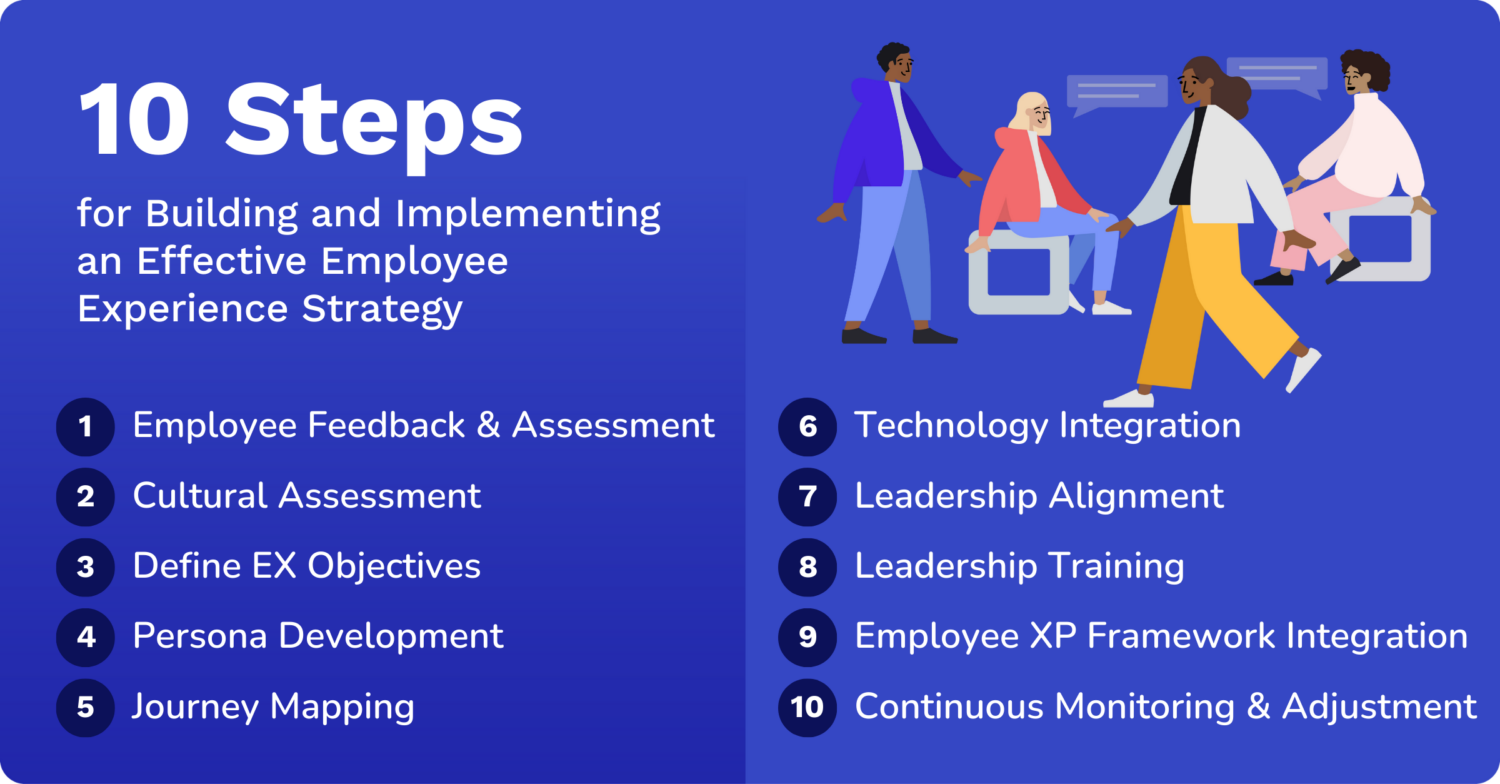
Although many organizations understand the importance of an employee experience strategy, they often struggle to effectively implement it. Here are some common challenges:
Without efficient communication, even the best-planned EX strategies can fail. There must be clear channels for communication and collaboration among the employees, managers, and the HR teams to ensure everyone is on the same page and to enable effective execution of strategies.
Employee feedback is the backbone of an effective EX strategy, but often, organizations do not have a robust system to collect and incorporate employee feedback into their strategies. The surveys need to be communicative, easy to fill and must provide in-depth insights. Using technology like survey templates or generative AI can help ease this process.
Resistance from managers often stems from the fear of losing control or discomfort with change. But, without their buy-in and active participation, it's difficult to build a positive employee experience. Continuous training and communication can help engage these crucial stakeholders in the cause.
Crafted with intent, an employee experience strategy can be a powerful tool for fostering a positive work culture, enhancing employee engagement, and driving better business outcomes. Building such a strategy requires commitment and consistency, but the resulting increase in productivity and employee satisfaction tremendously outweighs the effort.
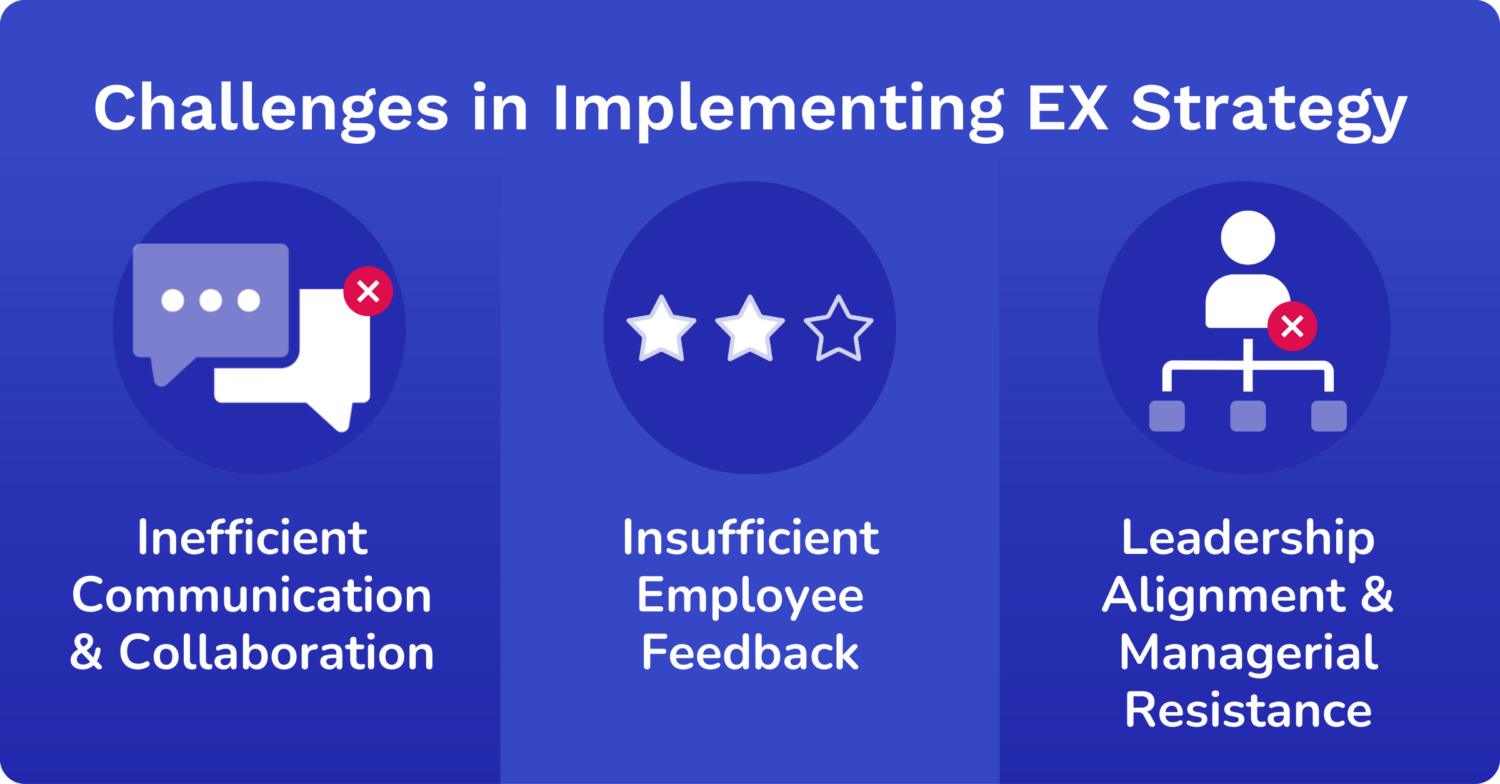
A positive and meaningful employee experience is key to boosting engagement among staff. When employees feel valued, empowered, and connected to the company's mission, they are more likely to be satisfied with their jobs, invested in the organization's success, and engaged as brand ambassadors. Companies that focus on understanding employee pain points through surveys and feedback opportunities can tailor support and resources to address issues.
Improving communication channels, providing opportunities for growth and development, fostering an inclusive culture, offering benefits that demonstrate care for the whole person, and recognizing contributions all lead employees to feel their needs are understood and met. With the many demands of today's workforce, an intentional strategy focused on crafting a supportive, fulfilling employee journey motivates staff and elevates performance to new heights through enhanced discretionary effort and commitment to collective goals. The result is a thriving and resilient organizational culture fueled by an engaged, vibrant workforce.
The key to a successful employee experience is a good, solid, effective internal communication that leads to employee engagement. Employees value communication, especially two-way communication, which increases involvement, participation in the organization, and meaningful input.
In a nutshell, Cerkl Broadcast offers versatile software that can help you achieve meaningful communication. Our platform offers a centralized hub that can accommodate every type of communication method. Its omnichannel capability is particularly effective for employee engagement because employees can access messages wherever they are, whenever it suits them. So, it suits remote, on-site, and hybrid workers, irrespective of their working hours. Additionally, Broadcast enables you to segment audiences to ensure that communications are valid for different audiences.
Broadcast is easy for internal communicators to access and manage, which is another benefit. It’s got great content scheduling features that communicators can use to plan the frequency and timing of messages. Another advantage for communicators is its customizable templates that you can use for Email Blasts and surveys.
The system is also ideal for feedback options, which is exactly what employees say they want. And there are many ways to invite feedback using the Broadcast platform.
At Cerkl, we recognize that there isn’t an internal communication plan that’s going to fit every requirement. Every business is different. But we can help you decide how to utilize the features that Broadcast offers so that you quickly improve your existing communications and improve employee engagement.
We suggest that your first step should be an internal communications audit. You can access our audit template here and we’ll help you take it from there.
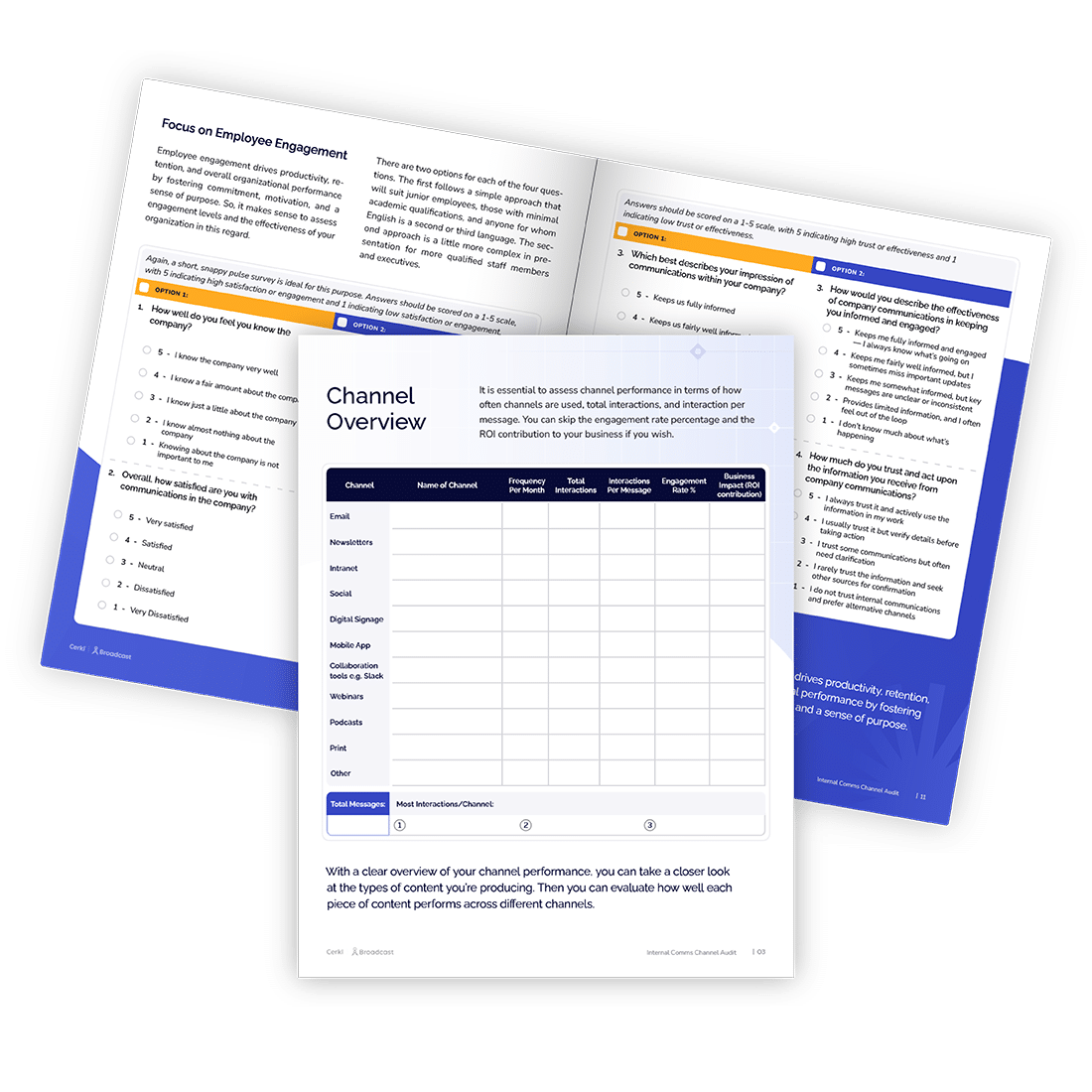
Upgrade your company’s internal comms to enhance employee communication
What is an employee experience strategy? An employee experience strategy is a holistic plan designed to enhance the overall employee journey and satisfaction of employees within an organization. It should focus on creating a positive work environment and improving employee engagement.
What are the 4 Ps of the employee experience? The 4 Ps of the employee experience generally refers to:
1. People in the workforce
2. Place, referring to the physical environment
3. Productivity and Performance, which cover work expectations and goals
4. Personalization, which relates to tailoring experiences to individual needs within the workplace
What is the employee experience strategy statement? An employee experience strategy statement is a concise declaration that outlines an organization's commitment to creating a positive and inclusive work environment. It emphasizes key principles and goals for enhancing the overall employee journey.
What is the employee experience strategy for HR? An employee experience strategy for HR involves aligning human resources practices with the organization's overall employee experience strategy. It encompasses areas such as recruitment, onboarding, professional development, and employee relations to ensure a cohesive and supportive work environment.

Upgrade your company’s internal comms to enhance employee communication